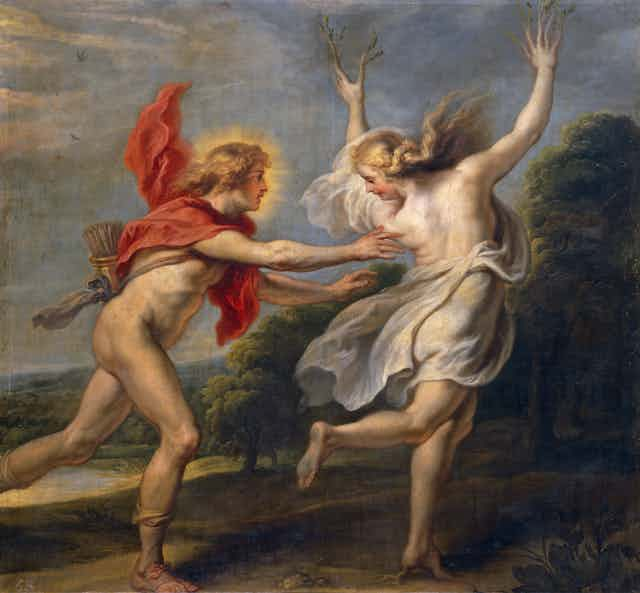Ovid’s Metamorphoses (AD 3-8) was not originally as controversial as his other poetic works. But as centuries have passed, its notoriety has increased. Recent calls to provide trigger-warnings to university students before they study the work tell us as much about modern Western attitudes towards sex, violence and censorship as the Metamorphoses tells us about the gender politics of ancient Rome.
Ovid’s 15-book epic, written in exquisite Latin hexameter, is a rollercoaster of a read. Beginning with the creation of the world, and ending with Rome in his own lifetime, the Metamorphoses drags the reader through time and space, from beginnings to endings, from life to death, from moments of delicious joy to episodes of depravity and abjection.
Such is life, Ovid would say.
The madness and chaos of some 250 stories, spanning around 700 lines of poetry per book, are woven together by the theme of metamorphosis or transformation. The artistic dexterity involved in pulling off this literary feat is testimony to Ovid’s skill and ambition as a poet. This accomplishment also goes a long way in explaining the rightful place the Metamorphoses holds within the canon of classical literature, placed as it is beside other great epics of Mediterranean antiquity such as the Iliad, Odyssey and Aeneid.
Kicking against the pricks
But for some, the Metamorphoses sits uneasily alongside its more morally and patriotically sound predecessors. Like a troublesome younger brother, an embarrassment to the family, Ovid’s epic “kicks against the pricks,” to paraphrase the paraphrase of Nick Cave.
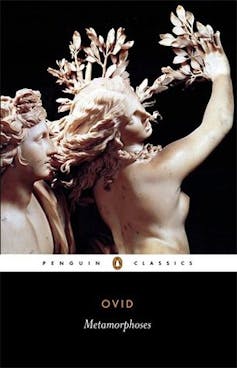
The Homeric Iliad (c. 850 BC) soars to the literary heights of the sublime, and shows us how to live and die, to meditate on mortality, to embrace sorrow, to grip and then release hate, to truly love.
The Odyssey (c. 800 BC) takes us on an epic voyage forever leading towards home, sometimes making us laugh, and occasionally letting down its high-brow hair with some sex and infidelity. Yet, appropriate to the gravitas of epic poetry, the Odyssey is also about the journey of a man determined to maintain his heroic stature as he navigates all sorts of dangers in strange lands.
Some 700 years later, when the Homeric verses were still regarded as the benchmark for epic poetry, Virgil composed the Aeneid (19 BC). This Latin epic casts a patriotic spell over its audience in its evocation of the foundation of Rome from the ashes of Troy to the glory of the Augustan Age. Unlike his poetic successor, however, Virgil is alert to literary censorship under the reign of Augustus (63 BC-AD 14), Rome’s first emperor, and carefully navigates its perilous terrain.
Rome is great according to Virgil. It always has been. It always will be. But Ovid is not convinced, and he seeks to capture an epic world of uncertainty and destabilisation instead of “drinking the Kool-Aid” that flows from Augustus’ fountains.
Ovid’s graphic tales of metamorphosis begin with the story of Primal Chaos; a messy lump of discordant atoms, and shapeless prototypes of land, sea and air. This unruly form floated about in nothingness until some unnamed being disentangled it. Voilà! The earth is fashioned in the form of a perfectly round ball. Oceans take shape and rise in waves spurred on by winds. Springs, pools and lakes appear and above the valleys and plains and mountains is the sky.

Lastly, humankind is made and so begins the mythical Ages of Man. And, as each Age progresses – from Gold, to Silver, to Bronze and finally to Iron – humankind becomes increasingly corrupt.
Ovid’s gods and humans never really escape the Age of Iron in the Metamorphoses. Throughout the epic, the setting that emerges in Book I functions as a brilliantly appropriate dystopic stage on which the poet-cum-puppeteer orchestrates his spectacles.
Drawing on the Greek mythology inherited by the Romans, Ovid directs his dramas one after another, relentlessly bombarding his readers with beautiful metrics and awe-inspiring imagery as that of Deucalion and Pyrrha, Arachne, Daphne and Apollo, Europa and the Bull, Leda and the Swan.
Hundreds of hapless mortals, heroes, heroines, gods and goddesses rise victorious, experience defeat, endure rape, and inevitably metamorphose into something other than their original forms. Chaos begins the world, and so into Chaos we are born, live and die. As the offspring of the Age of Iron, we must endure and struggle against corruption, brutality and injustice.
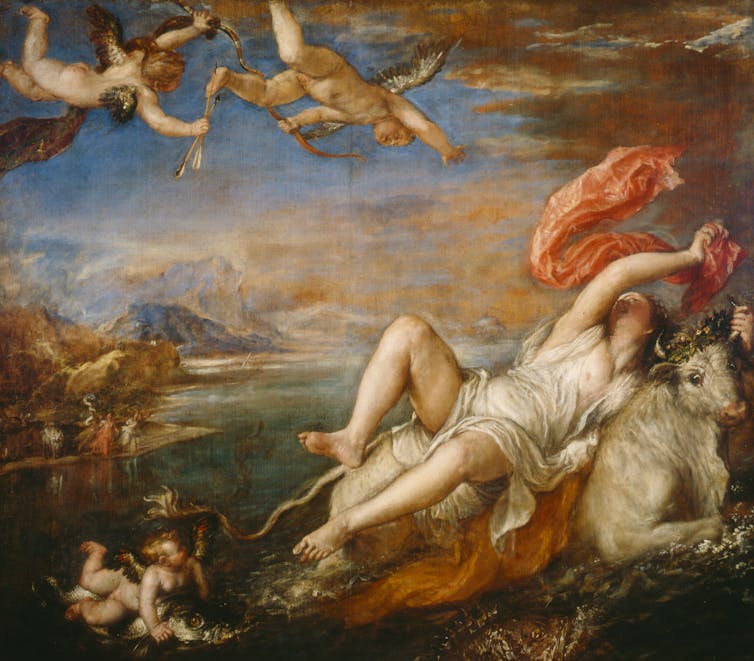
A poem and a mistake
Ovid experienced a world of chaos and iron firsthand when, in AD 8, he was banished by Augustus. His wrongdoings were, in his own words, carmen et error (“a poem and a mistake”).
The poem was the Ars Amatoria (The Art of Love), a three-volume lovers’ handbook that explains the dos and don’ts of personal grooming, how to organise trysts with married women (get her maid “on side”), repairing a broken heart (surprise your “ex” while she’s in the middle of her beauty routine – yuk!), names the best places for “hooking-up” (try the races or the theatre), and offers advice on keeping your girl (be attentive when she’s unwell). Interestingly, the third volume was written for women – quite a revolutionary move in view of the gender inequality in the twilight years of the 1st century BC.
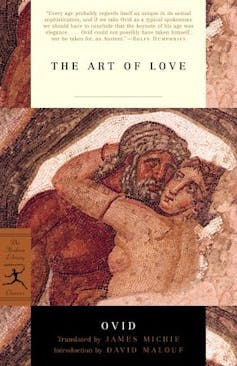
What irritated Augustus sufficiently enough to relegate the poet to the middle of nowhere was his perception that the Ars Amatoria made a mockery of his moral reforms. Not one for frolic, Augustus had spearheaded and implemented a series of legislative campaigns that raised the moral bar for the goodly citizens of Rome. Adultery, while always illegal in Rome, was made especially so under the watchful eye of the emperor and legal ramifications were more actively enforced than in previous decades.
The mistake that Ovid mentions is more difficult to identify – with scholarly opinions differing on what it was Ovid actually did to offend Augustus. Theories range from Ovid engaging in an affair with one of the imperial women – perhaps Augustus’ daughter (Julia the Elder) or granddaughter (Julia the Younger) – to his accidentally witnessing an imperial scandal.
Whatever the error, combined with the ill-themed Ars Amatoria, it was sufficiently serious to result in Ovid’s banishment to Tomis (Constanța in modern-day Romania). Tomis, at the very edges of the Roman Empire, was regarded as a barbaric, frightening and uncivilised place. Ovid certainly painted it this way in his poetic epistles, the Tristia (Sorrows) and Epistulae Ex Ponto (Letters from the Pontus).
Forced to exist in a place where his native Latin was scarcely heard, Ovid’s despair is evoked in one of his most memorable couplets: “writing a poem you can read to no one / is like dancing in the dark.”
For the optimal punishment of Ovid, Augustus chose his location well, and he never reneged on his decision. Nor did his successor, Tiberius (42 BC-AD 37).
Ovid died in Tomis in AD 17.
An epic about silencing
In one of the definitive pieces of scholarship on the Metamorphoses, Reading Ovid’s Rapes (1992) by classicist Amy Richlin, it is argued that the epic was completed during Ovid’s time in Tomis. This may not initially appear to have any bearing on its content or intent, yet Richlin suggests a profound relevance:
The silenced victims, the artists horribly punished by legalistic gods for bold expression … read like allegories of Ovid’s experience …
Accordingly, Tomis not only gave Ovid time to augment the poem in view of his own experiences but, equally as important, its composition was being finalised during the emperor’s inquisition into the carmen et error.
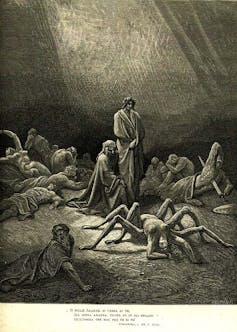
Indeed, Ovid’s own silencing by Augustus may be seen to be enacted over and over again in the Metamorphoses in the most grotesque of ways. Ovid’s tales describe tongues being wrenched out, humans barking out their sorrows instead of crying, women transformed into mute creatures by jealous gods, and desperate victims bearing witness to their abuse through non-verbal means.
The Metamorphoses is an epic about the act of silencing.
Jealousy, spite, lust and punishment are also consistently present in Ovid’s chaotic world.
So is rape.
Rape is undoubtedly the most controversial and confronting theme of the Metamorphoses. It is the ultimate manifestation of male power in the poem and the hundreds of transformations that occur are often the means of escaping it.
An early tale of attempted rape is narrated in Book I, involving the nymph, Daphne and the god, Apollo. Intent on raping Daphne, Apollo chases her through the forest until, utterly exhausted, she calls out to her father, the river god Peneus to rescue her:
“Help, father!” she called. “If your streams have divine powers!
Destroy the shape, which pleases too well, with transformation!
Peneus answers his daughter’s entreaty, and Daphne is transformed into a laurel tree:
… a heavy torpor seizes her limbs,
her soft breasts are encircled with thin bark,
her hair changes into leaves, her arms change into branches,
her feet once so swift become stuck with stubborn roots,
her face has a leafy cover; only her elegance remains.
The tale of Daphne and Apollo, like so many stories in the Metamorphoses, is classified as an aetiological myth; that is, a narrative that explains an origin. But, as the excerpt above testifies, it is so much more than that.

Reading Ovid now
Where does a modern audience begin with a story such as Daphne and Apollo?
How do we begin to unravel the hundreds of other such tales that follow it?
During the last few years, the Metamorphoses has been challenged as a legitimate text for tertiary Humanities students. Defying the hundreds of years of pedagogical tradition that has seen the poem set for both Latin students and, more recently, literary students who study it in translation, the Metamorphoses has not only been interrogated by scholars such as Richlin, but has also been the subject of increased student complaints and calls for trigger-warnings.
In response to the growing number of objections to the work, academic and university executives have been called on to take a position – not only in relation to the Metamorphoses, but in response to other materials that are perceived to render the tertiary experience unsafe.

The Chancellor at Oxford, Chris Patten, has been quoted as saying that history cannot be rewritten to suit contemporary western morals. At the opposite end of this debate, are students such as the members of Columbia University’s Multicultural Affairs Advisory Council, who have challenged the inclusion of the Metamorphoses without an explicit trigger-warning in one of the core curriculum courses in the Humanities.
How close such responses to the Metamorphoses verge on literary censorship or, in the words of one journalist, Literature Fascism, does not only depend on one’s philosophical or educational viewpoint. Equally as important to the debate, and the decisions that may ultimately result from it, is the life-experience of every individual in the classroom. Amid a class of students taking notes from a lecture on the Metamorphoses, for example, may be a rape survivor.
Current statistics from the United States in particular suggest that the likelihood of this is exceptionally high. Emerging statistics from across Australia are painting a similar picture.
Such a situation requires alertness and sensitivity when handling texts such as the Metamorphoses. But should the work of Ovid be banned or placed among the shelves marked "Warning: Wicked Books”? What would such measures ultimately achieve? Would it augment safe spaces? Or, would it censor discussions around rape and shut down interrogations of sex, violence and female exploitation? Would it silence one of the means of opposition to the societal sickness of rape?

The Metamorphoses of Ovid has had a long and fascinating history. Its presence among the literary canon of the West has functioned as a strange but valuable mirror that has, for over two millennia, reflected social, moral and artistic customs.
From the time that Shakespeare read Arthur Golding’s 1567 translation and incorporated so many of the stories into his plays, to the thousands of artworks that have been inspired by the poem, to Barrie Kosky and Tom Wright’s 2006 extravaganza, The Lost Echo, to the production in the 2016 Sydney Fringe, to the student protests and the calls for trigger-warnings, the Metamorphoses – much like Ovid himself – simply refuses to go away.
Much like the self-portrait by Albrecht Durer, Olympia by Edouard Manet, the works of modernist painters that enraged European Fascists, Tracey Emin’s My Bed, the installations at MONA, Joyce’s Ulysses, and a host of films and photomedia, Ovid’s Metamorphoses testifies to the fact that great art is not necessarily created to please.
Recommended reading: Metamorphoses: A New Translation Paperback by Ovid, translated by Charles Martin (2005).
Montague Basement’s Metamorphoses is currently showing as part of the Sydney Fringe Festival.

